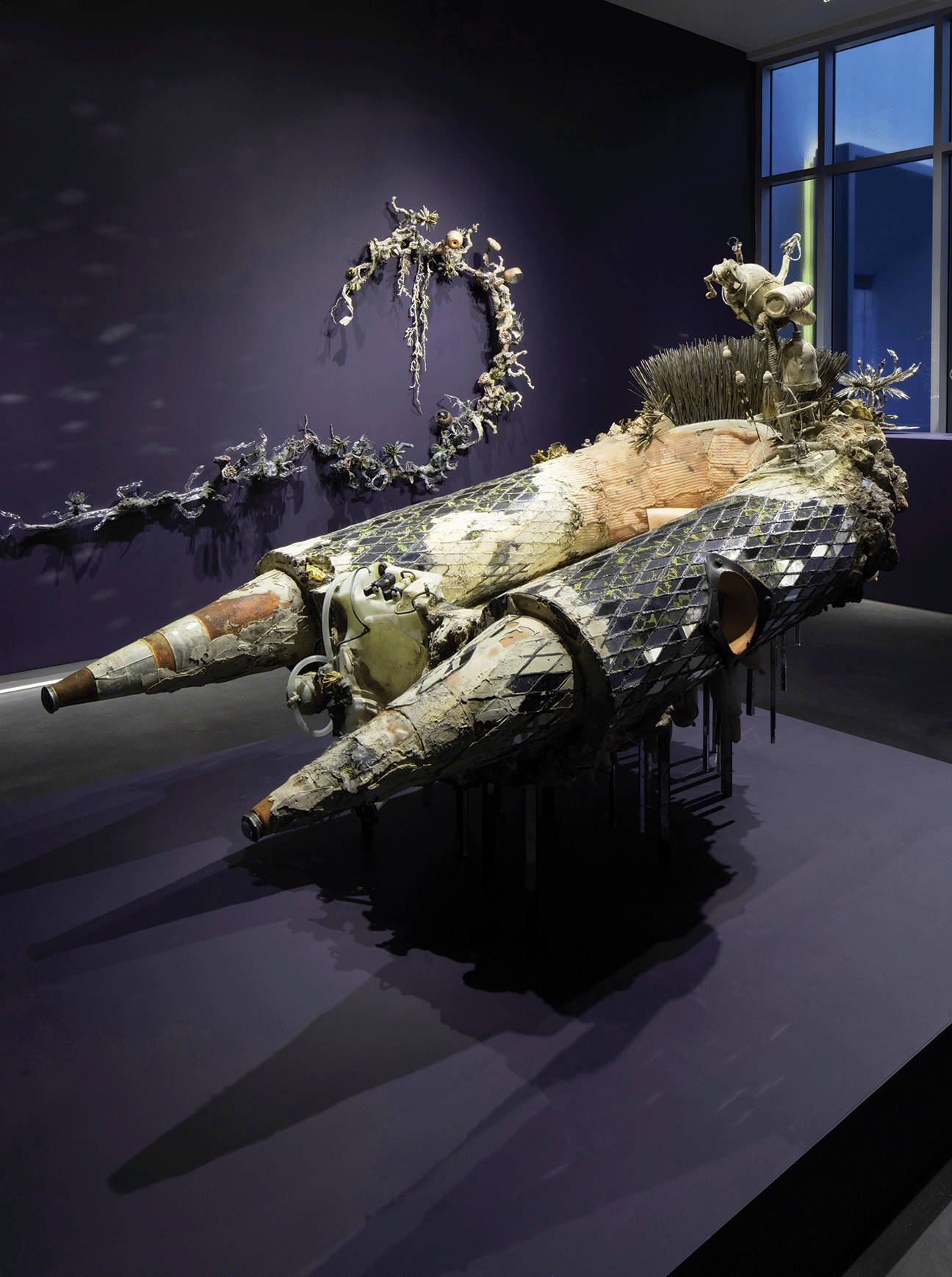« Reviews
Monica Cook: Liquid Vessels
SCAD Museum of Art - Savannah, GA
By Friendship Magic Collective
Monica Cook’s “Liquid Vessels” at the SCAD Museum of Art invites you to travel across time and space in an archaic watercraft and examine a mysterious and beautiful collection of baroque relics from a fictional civilization.
This concise exhibition, which includes seven works (five sculptures and two drawings), provides a portal to the expansive world that Cook has created in past exhibitions. It zooms in on the materiality of Cook’s figurative work and focuses on her process of material investigation. The small exhibition space, painted a deep aubergine, creates an intimate, opulent experience for the viewer to focus on the surface patina of each work.
Much of the work is immediately compelling on a material level. Reflective glass, silvering, and copper glimmer beneath cast silicone, nylon mesh, resin, and plaster. The work itself appears to have been excavated, and as you spend time with it, each piece draws you into the process of further puzzling and untangling. These objects are not shiny and new, but shiny and ancient, dug up from a ruin or the sea bed and encrusted with calcified earth. They transform visitors from onlookers to curious explorers enthralled in the act of uncovering and connecting.
Receiver is the centerpiece of the exhibition. The watercraft occupies the center of the gallery, perched at an angle atop dozens of mirrored glass rods that connect it to the low pedestal a few feet below. The piece is frozen in motion like a taxidermy animal mid-pounce, as if to suggest a dynamic past life of skipping over sea waves. Here is a monkey-size hybrid vagina/boat with a found fragment of a brush from a street sweeper on the prow that references a whale baleen, and old plastic tubing erupting informally from the interior of the berth. The vessel is lined in fleshy corn-textured silicone, nude pantyhose stretching across a bow slathered with plaster embedded with hitchhiking shells, barnacles, and other salty debris. Yet, the hull of this provisional craft is lovingly-pieced with perfectly tessellated mirrored glass. The fearlessness of creating such a convincing vehicle from this playful hodgepodge is invigorating.
The other works in the exhibition surround Receiver, enriching the story of functionality and history that Receiver’s boat-like form and bizarre array of materials imply. Cook’s small and intricate glass sculptures, Nest, Honeypot and Seven of Fronds, are at eye level just inside the door of the exhibition space. The symmetry, glasswork, and elegant curvature of these vessels evoke Baroque crystal vases and elaborate Baptismal fonts, while the sea urchin spines, beehive, silvered chains, copper tape, twine and blown-glass animals adorning them defy classification and push them closer to psychedelic paraphernalia territory. These works are mysterious and captivating because they combine materials we recognize into complex objects beyond our wildest imaginations.

Monica Cook, Hydrilla Aerostar, 2018 (background), glass balls, gold leaf, gold powder, ground mica, aqua resin, acrylic, starfish, artificial foliage, pipe cleaner, wire, plastic grapes, glass globes, feathers, dried lotus pods and drift wood, 80” × 80." The Receiver, 2016 (foreground), silicone, mirror, steel, barnacles, safety cones, aqua resin, sea urchin spines, coolant tank, resin, telephone cord, rubber tubing, 67” × 103” × 60." Courtesy of SCAD Museum of Art.
The expansive wall-mounted sculpture, Hydrilla Aerostar, which stretches across the gallery wall between the classical glass vessels and the Receiver, operates the same way. At first glance, it is a graceful tree branch arching across an expanse of violet wall. Up close, it is laden with organic and manmade detritus: seed pods, shells, spines, glass, chain, etc. It is embedded and caked with traces of Cook’s studio universe.
While many of her past exhibitions lay a more complete narrative at the viewer’s feet through representational painting, video and figurative sculpture, this exhibition only alludes to that world. Her iconic monkey characters are present only as drawn silhouettes and small blown glass embellishments. Her mixed media drawings, Tincture I and Tincture II, function more as cave paintings. Here we see the monkeys at work with corn cobs, bottles of Dawn, and other familiar motifs of Cook’s imagined civilization. Much like Cook, the characters are tinkering. They are definitely making something, but what? When? These questions echo in the mysterious sculptural works.
Cook’s restless experimentation, her quest to learn and master new materials and processes, are on full display here. For us, the thing that is most admirable is Cook’s ability to ignore the pressures of career and maintain and cultivate her personal sense of wonder in the making, pushing past what she knows in favor of discovering the unknown. The power and beauty of this art comes across in the strangeness. Monica Cook has found a joyful way to produce a body of work from an experimental and curiosity-based practice. She has built an entire world on the mysterious, grotesque and tactile language of raw material. This exhibition provides an opportunity to relish in that joy and ambiguity.
(February 14 - May 19, 2019)
Friendship Magic Collective (FMC) is a two-person project initiated in 2017 by Honor Bowman Hall and Gregory Eltringham. Their ongoing project is engaged in a range of activities including studio production, writing, and musical performance, all organized around the following concept: Enjoyment is part of the Program. FMC lives and works in Savannah, GA.
Filed Under: Reviews



































Leave a Reply
You must be logged in to post a comment.